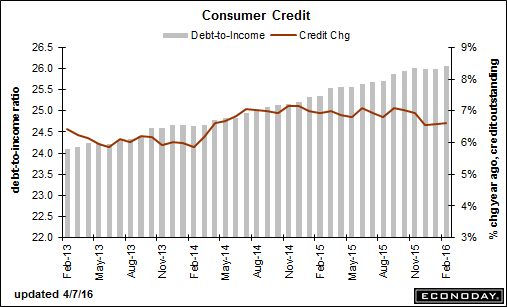In addition to very large Consumer credit borrowing that rose $17.2 billion in February (but excludes mortgage lending), the number of new first mortgages increased markedly in 2015, according to new data from credit rating company Equifax. In fact, mortgage lending is approaching pre-recession levels thanks to the Fed's low interest rate policy, which will help the housing shortage by stimulating more new-home construction.
This is in spite of the Obama Administration's efforts to dissolve Fannie Mae and Freddie Mac, which continue to guarantee the bulk of affordable mortgage loans. A recent New York Court ruling has unsealed many of the Obama Administration's documents that detail how the U.S. Treasury probably knew Fannie and Freddie were still solvent and about to see some $50 billion in profits in 2012, at the same time that Treasury amended their conservator agreement in order to rake in all of its profits into the General Fund, which prevented the GSEs from building up a capital reserve to protect them from future economic downturns.
According to the company's latest National Consumer Credit Trends Report, the total number of new first mortgages originated in 2015 rose to 7.71 million, an increase of 31.6 percent from 2014. Meanwhile, the total balance of new first mortgages was $1.82 trillion, a year-over-year spike of 42.9 percent. Equifax also found that first mortgage lending to subprime borrowers grew in 2015, with 366,900 loans made - an increase of 25.2 percent over 2014 - and a total subprime balance of $59.7 billion, a 41.3 percent increase.
"We saw a nice jump in mortgage lending in 2015 that was driven by both rising home-purchase activity and solid refinancing volumes," said Amy Crews Cutts, Equifax senior vice president and chief economist. "While low interest rates are helping, continued gains in employment and consumer confidence are key. What we are not seeing is any meaningful loosening of underwriting, at least with respect to credit scores. The median credit score on new first mortgages in the fourth quarter of 2015 was 750 and 90 percent of first mortgage borrowers had a score in excess of 646; these values are essentially unchanged for the past three years."
The preponderance of such high credit scores is a major reason why the housing market has been so slow to recover. The so-called qualification criteria of conforming loans have become ever stricter since the housing bubble. It is even more difficult to qualify for a subprime mortgage, or the origination volume would be even higher.
There is a reason for the higher credit scores. Both Fannie and Freddie add large 'penalties' for credit scores lower than 720. This discourages many borrowers, as the US Treasury and the Federal Housing Finance Authority (FHFA), their nominal conservators, want to shrink the GSEs portfolio, rather than expand their credit guarantees.
Why? It's a long story, but the Treasury (the real puppeteer pulling their strings) has said several times they want to dissolve the GSEs, and have Congress replace them with something more streamlined, but without an implicit government guarantee. The catch is it will raise interest rates, since the latest Treasury proposals require originating lenders to put skin into the game (such as retaining some liability even when sold to investors), which defeats the purpose of making home ownership more available.
This overturns the reasons Fannie Mae, created as part of Roosevelt's New Deal, and Freddie Mac, created post-WWII, were created. They were never the cause of the housing bubble and bust, as were Lehman Brothers and Bear Stearns, major originators of subprime loans without adequate collateral, or S&P and the other credit rating agencies that fraudulently certified those loans as AAA rated.
Why on earth does the Obama Administration oppose the GSEs, which should be encouraging homeownership as part of the FHFA's mandate, as long as there are eligible home buyers, and nothing in place to replace them and keep homeownership affordable?

